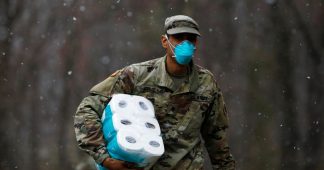By Benjamin Mateus
Last week, during the World Health Organization (WHO) press brief, Dr. Mike Ryan, executive director for the WHO emergencies program, observed, “We are not in an epidemiologically stable situation. The virus is still working its way through the human population. A vast majority of people remain susceptible. So, it has not settled down in a pattern that we can predict.” He also highlighted that though the pandemic is raging across Europe and North America, most of the world’s population remains susceptible to the coronavirus.
This week saw the highest number of cases and deaths globally. On Wednesday, 13,579 people succumbed to the infection, and on Thursday, almost three-quarters of a million people were infected. Of the 75.7 million cases of COVID-19, 20.9 million were active cases of infection, with more than 107,000 in critical condition. There are have been 1.676 million deaths thus far.
Europe has registered 22.884 million cases. After a sharp rise in October, cases peaked at 333,344 on November 7. However, limited restrictions and piecemeal non-pharmaceutical interventions employed to turn the curve have led to a tepid decline that has seemed to stall at around 244,663 cases per day. Since November 9, weekly deaths have exceeded 30,000 and over 35,000 per week since November 23.
Long touted as the country that fared better than its European neighbors, Germany has now become the epicenter of the pandemic in Europe with more than 30,000 cases yesterday for a new one-day high. Deaths have also dramatically followed the surge. On December 15, there were around 800 deaths alone, and the seven-day average has seen more than 500 fatalities per day.
Given its experience in the spring with its health system intact, the government enacted the mildest lockdown during the winter surge, leaving shops, offices and factories open. This left the country vulnerable to the devastation being wrought by the pathogen. Christian Kleber, an emergency room physician from Dresden who is in charge of coordinating the redistribution of COVID patients across the region, told the Wall Street Journal, “Our hospitals are at the limit of what they can manage.” The health system is expected to reach capacity at the current pace of infections. In Hanau, Germany, bodies are being kept in metal shipping containers as morgues have reached capacity. The government has moved to impose “a harder” lockdown at least until January 10.
On Wednesday, the United States experienced its single worst day with 250,173 cases of COVID-19 and 3,561 fatalities. With 17.8 million cases, the death toll has rapidly reached 320,000. Yet, no effort is being employed to quell this deluge of death sweeping across the nation. The life-saving vaccines being ushered in as the panacea to the virus are now facing glitches in distribution. Several states have been told that they would be receiving fewer doses of the Pfizer vaccine next week, which means that states have to readjust plans to deliver the vaccines to their citizens.
Governor Gretchen Whitmer of Michigan complained, “Where are our doses? What is holding them up? There are millions of Pfizer vaccines, many right here in Portage, Michigan, that are waiting to be shipped, but the feds are slow-walking the process of getting addresses to Pfizer for some reason I cannot get an answer to.”
Meanwhile, California has seen an unprecedented surge in cases that has led to daily record highs and an announcement that Southern California’s intensive care beds are wholly occupied. Nearly 400 deaths were reported on Thursday, with over 60,000 new cases on Wednesday. There are more than 15,000 people in hospitals and over 3,000 in the ICUs. Across the state, fewer than 1,300 ICU beds remain open. Speaking to CNN, Dr. Brad Spellberg, chief medical officer at LA County and USC Medical Center, said, “We’re getting crushed. I’m not going to sugarcoat this. We are getting crushed.”
Despite a slow decline after the summer peaks, Mexico has seen a rapid climb in cases that has reached new highs. There have been close to 1.3 million reported cases and over 116,000 deaths. The seven-day moving average in fatalities has climbed close to 600 a day. However, these figures are known to be severely underestimated.
In an official survey conducted in Mexico City, Juan Rivera, the general director of the National Institute of Public Health, explained during a news conference that seroprevalence studies suggested that a quarter of Mexico’s population, around 31 million people, have been exposed. The blood tests that detected antibodies to the coronavirus were collected between August and November, which involved 9,400 households.
With cases soaring again, Mexico City will shut down all nonessential activities commencing this weekend until January 10. These measures are being driven as the hospital occupancy has exceeded 75 percent, and limited actions have done little to stop hospital admissions nor fatalities. Dr. Marta Patricia Mancilla, who works at Mexico City’s Ajusco Medio hospital, named as one of the few exclusively COVID-9 hospitals, said, “The worst is still to come. And unfortunately, it is going to catch us very tired.” The patient capacity runs at 122 percent, while the ICU is at 116 percent and emergency units at 100 percent. Additionally, almost 2,000 Mexican health care workers have thus far died from COVID.
Brazil has shown that the virus has little to do with seasonality. With its summer approaching, cases of COVID have reached their July highs. On Wednesday, it registered over 70,000 new cases. Daily deaths have followed in kind, reaching a one-day high of more than 1,000 just yesterday. This staggering figure was last reported on September 15. During the pandemic, there have been 7.16 million cases of COVID and 185,650 deaths in the country.
These figures do not include the number from São Paulo state, which has reported technical issues with uploading their numbers. São Paulo state, the nation’s most populous region, has been the epicenter of this wave. The government has thus far resisted issuing lockdowns or restrictions, which have contributed to this present crisis.
Brazil’s supreme court issued an order that imposed time limits on when bars and restaurants could serve customers. The court also noted that if individuals refused to take the vaccine, they could face sanctions or imposition on their liberties. At odds with the court, Jair Bolsonaro, Brazil’s fascistic president, has repeated that he refuses to take the vaccine and that ordinary citizens would not be required to do so.
Like in the United States, COVID has become the leading cause of death in the Americas. It now surpasses coronary heart disease as the number-one cause of death in Brazil, Chile, Ecuador and Panama. Latin America accounts for 48 percent of the COVID-19 deaths. The endemic poverty, crowded living conditions, and underfunded and fragmented health care systems have primarily contributed to these developments.
Carissa Etienne, the head of the Pan-American Health Organization, told NPR, “The many millions who rely on the informal economy for their livelihood didn’t have the option to stay home. And for people in marginalized settings and remote areas—like our indigenous communities and migrants—proper health care was often out of reach.”
South Korea and Japan, which had been held up as examples of employing strong public health measures, have been sidelined by the coronavirus’s sudden resurgence within their communities. South Korea has seen cases jump to over 1,000 per day, while in Japan, new cases reached a one-day high of more than 3,000 yesterday.
Still, on the deadliest day of its experience with the pandemic, South Korea has reported 22 deaths. But experience has shown that these developments can rapidly escalate. There are 12,209 active cases, and 242 are in serious or critical condition. The majority of these cases are located in the densely populated metropolitan area of Seoul. As the AP noted, “The viral resurgence came after months of pandemic fatigue, complacency and government efforts to breathe life into a sluggish economy ” (emphasis added). While the government is agonizing over placing restrictions in place that would impact more than 1.2 million businesses, the health ministry data indicated that the greater Seoul area’s critical care capacity is reaching its limit.
The Tokyo Metropolitan Government has raised its health care alert to the highest level as the number of new cases reached a single-day high. In the meantime, Japan’s Prime Minister Yoshihide Suga has apologized for attending a dinner with friends and celebrities while the country was seeing a surge in cases.
Masataka Inokuchi, the vice-chair of the Tokyo Medical Association, explained at a news conference attended by the Tokyo Governor Yurike Koike, “We fear a serious dysfunction of the medical system in two weeks, on December 31, if the number of new daily infections keeps growing at the current pace.”
According to the IMF’s latest projections, per capita growth in 170 out of 190 economies will be negative for 2020. According to the Brookings report from November, for the first time in 50 years, “the global consumer class will shrink.” Even more concerning, extreme global poverty is expected to rise for the first time in 20 years, pushing an additional 27 million, or a total of 115 million, into destitution. This is expected to rise to 150 million by 2021 due to economic contractions.
The present surge across the globe is a byproduct of lifting restrictions on commerce by every major nation whose economy faces stagnation. Yet, these actions are leading to mass infections and deaths. According to the World Bank, “the pandemic and global recession may cause over 1.4 percent of the world’s population to fall into extreme poverty.” Only the international working class has the means to address the pandemic and social misery being inflicted on the planet’s population.
Published at https://www.wsws.org/en/articles/2020/12/19/pand-d19.html











